Station-model sets
Standardized Sets by The Broadcasting Corporation of Japan
1938-45
Introduction
"Station-model set" is one of the well known Japanese radio
sets.
In the mid-1930's, NHK(*1) was suffered from the trouble of low quality
cheap radio sets.
NHK operated the recommendatory system of wireless apparatus. However,
expensive approved radio was not prevailed.
In 1933, The information of "Deutshe Volks Empfanger" gave the hint to spread high quality radios at low cost.
"Station-model set" was planned as Japanese standard radio set.
Like a German people's radio, the design of standard radio is unified a few models.
The details of construction (such as circuit, parts, design and measurements
of cabinet) and price were fixed by regulations issued by the broadcasting
authorities (NHK). All manufacturers products same types of sets.
Standard radio was inspected and supplied by NHK at reasonable price.
Radio manufacturers and suppliers opposed to this plan. However the controlled economy at wartime helped this standard radio project.
In 1939, "Station-model set" was certificate by government as
a standard radio.
5 types of "Station-model set" were produced.
The No.123 4tube TRF transformer-less receiver is most mass produced Station-model
set.
(*1) In those days, Only one broadcast station existed in Japan.
This is "Nippon Hoso Kyokai (The Broadcasting Corporation of Japan)".
Now It was called "NHK". This abbreviation "NHK" was
used from 1946.
Until 1945, It was called "Hoso Kyokai". We will use "NHK" in this article.
NOTICE:
Gothic is latest updates.
Japanese terms or company
names that is untranslatable are shown in spelled in Italics.
When not mentioned specially, all prices are original retail price.
HOME
CONTENTS
History and Models
Announcement of the Plan of Standard Radio and Opposition by Radio Industry
Trial Manufacture and Public Announcement of Radio Set
Type No.1 Receiver The Nihon Seiki Co., Ltd. 1939
Type No.3 Receiver The Nihon Seiki Co., Ltd. 1940
Failure of First Station-model set
Approved Manufacturer for Station-model set
Type No.11 Receiver -Reduced Material Radio-
Type No.11Receiver (Early) Taiyo Radio Manufacturing Co., Ltd. 06/1940
Type No.11Receiver (Early) The Osaka Musen Co., Ltd. 09/1940
Type No.11 Receiver (Mid) Hakusan Musen Denki K.K. 1941
Type No.11Receiver (Mid) The Osaka Musen Co., Ltd. 05/1942
Type No.11Receiver (Later) Hakusan Musen Denki K.K. after 08/1942
Kahoku Standard No.11 Receiver The Nihon Seiki Co., Ltd. 1940
Development of Transformer-less Receiver Type No.122 and 123: New Transformer-less "Station-model set"
Type No.122 Receiver Nanao Radio Co., Ltd. 11/1941
Type No.122 Receiver Ishikawa Musen Denki K.K. 12/1941
Type No.123 Receiver (Early) Nanao Radio Co., Ltd. (Approved No.12306) (08/1941)
Type No.123 Receiver (Early) Haraguchi Radio Co., Ltd. (Approved No.123011) (03/1942)
Type No.123 Receiver (Early) Nippon CHikuonki Shokai K.K. (Approved No.123014) (1942?)
Reinforcement of Control for Radio
Improvement of Type No.123 Receiver -Temporarily Permitted Model-
Type No.123 Receiver (early temporarily permitted model) Tiger Electric Co., Ltd. (Approved No.12305) (1942?)
Type No.123 Receiver (temporarily permitted model) Matsushita Radio MFG. Co., Ltd (Approved No.12309) (04/1942)
Type No.123 Receiver (early temporarily permitted model) Yaou Musen Denki Seisaksho (Approved No.123015) (05/1942)
Type No.123 Receiver (temporarily permitted model) Hayakawa Electric Industry Co., Ltd. (Approved No.12308) (05/1942)
Type No.123 Receiver (temporarily permitted model) Nanao Radio Co., Ltd. (Approved No.12306) (10/1942)
Type No.123 Receiver (temporarily permitted model) Tone Musen K.K. (Approved No.12305) (08/1943)
Lack of Materials, Last Model of Type No.123 Receiver
Type No.123 receiver (Square Shape) Matsushita Radio MFG. Co., Ltd. (Approved No.12309) 06/1944
Type No.123 receiver (Square Shape) Hakusan MusenDenki K.K..) (Approved No.123012) 05/1944
Type No.123 receiver (Square Shape) Mitaka Denki K.K. (Approved No.123013) 1944?
Type No.123 receiver (Square Shape) Haraguchi Radio Co., Ltd. (Approved No.123011) 1944
Type No.123 receiver (Square Shape) The Osaka Musen Co., Ltd. (Approved No.12307) 1944
The Technical Problems of No.123 receiver
The Statistics of Production of "Station-model set"
After End of the War, from Station-model into Kokumin-gata
Data
Circuit Diagrams
HOME
Announcement of the Plan of Standard Radio and Opposition by Radio Industry
The plan of standard radio started from 1936. According to this plan, all
approved manufacturers must produce the same type approved set.
Standard radio is sold to customers by NHK at the same price.
Manufacturer, whole seller, and retailer will loss their business or gain.
They opposed to this plan strongly. The Ministry of Posts and Telecommunications
meditated to NHK and the radio industry.
In June 23, 1938, they were compromised.
TOP
Trial Manufacture and Public Announcement of Radio Set
In 1937 trial manufacture was progressed. 4 types of set were planned.
Type No.1 and No.2 was regenerative 3 tubes receiver. Type No.3 and No.4
was regenerative 4 tubes receiver with RF stage.
No.1 and No.3 were basic models equipped with magnetic speaker.
No.2 and No.4 were high-grade models equipped with dynamic speaker.
At the wartime high-grade models were not realized.
In January 1938 , the technical specification for type No.1 and No.3 receiver.
These were the first "Station-model set".
TOP
Type No.1 Receiver mfr:The Nihon Seiki Co., Ltd. 1939
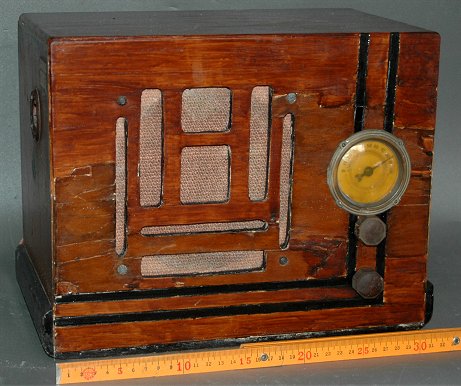
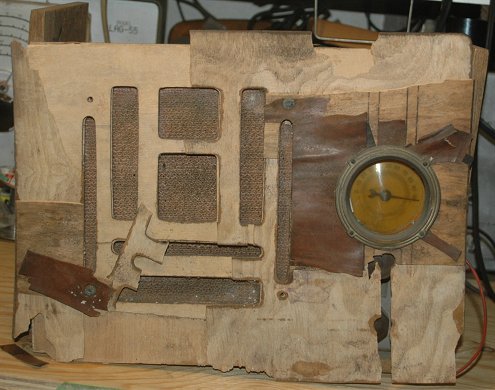
Before Restoration(right)
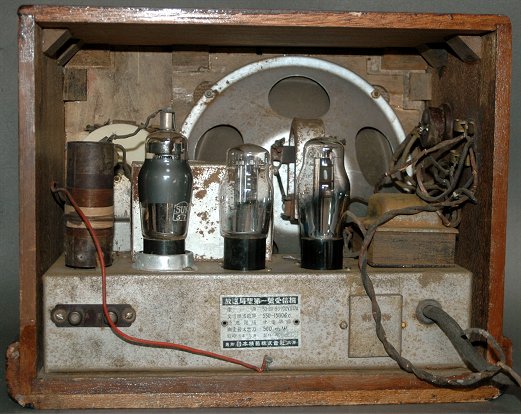
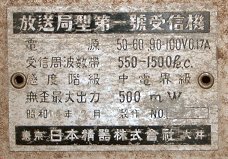
Type No.1 receiver is regenerative receiver with 3 tubes. Line up of tubes
is 57(detector), 47B(AF amplifier), 12F(rectifier).
This set uses plate detector to improve a tone quality and regenerative control is semi-fixed to avoid interference by over regeneration.
By these technical specifications, sensitivity of this set is lower than regular radio set with similar tubes.
(Collection No.11523)
TOP
Type No.3 Receiver mfr:The Nihon Seiki Co., Ltd. (05/1940)
Type No.3 receiver is regenerative 4 tube receiver with RF stage.
This set also uses plate detector and regenerative control knob is semi-fixed.
It’s installed behind the chassis. By these technical specifications,
sensitivity of this set is lower than regular radio set with similar tubes
too.
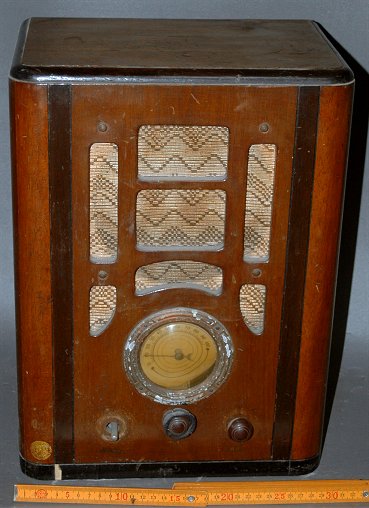
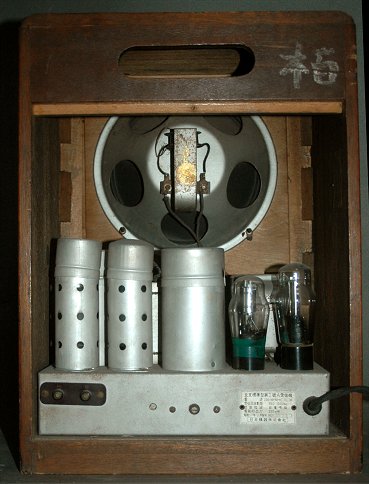
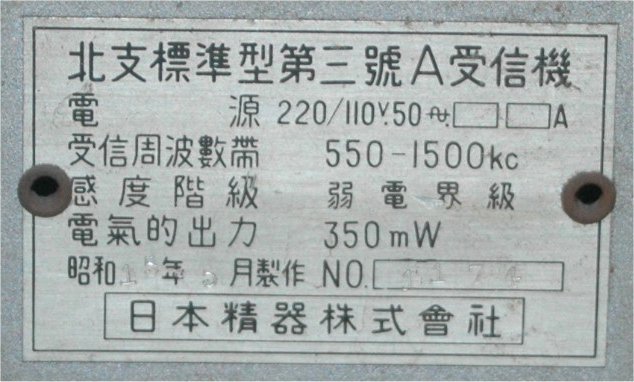
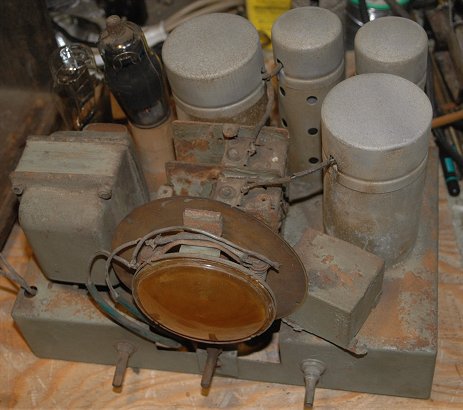
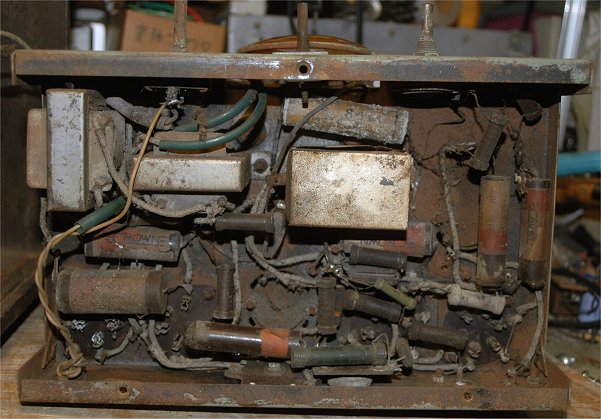
Derived model of type No.3. This is export for China. mfr:The Nihon Seiki
Co., Ltd. (1940)
Difference between domestic and export model is only power line voltage. Export model can be selected 110 and 220VAC.
(Collection No.11539,11788)
TOP
Failure of First Station-model set
In February 1939, Type No.1 and No.3 receiver was released from The Nihon
Seiki Co., Ltd. against opposition of radio industry. However , such low
sensitivity receiver was not accepted by market. And design of No.1 and
No.3 receiver was not concerned with saving strategic materials.
These sets were not matched to requirements of wartime.
Type No.1 receiver was not supplied to customers. And No.3 receiver was not mass produced except export model for China.
Trial produced sets were used by broadcasting station as PR tool.
TOP
Approved Manufacturer for Station-model set
Approval by the minister of communications must need to produce the"
Station-model set".
Authorized manufacturer equipped test instruments and tested all products mandatory.
Approval had given to 19 manufacturers which has large scale factory.
All products were inspected by NHK. The approval mark indicated passed
set .
Manufacturer and Approval No.
| BRAND |
COMPANY NAME |
No.1
No.号 |
No.3
No. |
Type No.1,3
Apr.Date |
No.11
No. |
Type No.11
Apr.Date |
No.122
No. |
Type No.122
Apr.Date |
No.123
No. |
Type No.123
Apr.Date |
ADRESS |
| Crown |
The Nihon Seiki Co., Ltd. |
101 |
301 |
25/01/1939 |
1101 |
16/12/1939 |
12201 |
10/01/1941 |
12301 |
10/01/1941 |
Shinagawa, Tokyo |
| Televian |
Yamanaka Electric Co., |
|
|
|
1107 |
26/03/1940 |
12202 |
01/03/1941 |
12302 |
01/03/1941 |
Ohji, Tokyo |
| Erman |
Taiyo Radio Manufacturing Co., Ltd. |
104 |
304 |
16/12/1939 |
1103 |
23/01/1940 |
12203 |
01/03/1941 |
12303 |
01/03/1941 |
Ohmori, Tokyo |
| Wave |
Ishikawa Musen Denki K,K. |
|
|
|
11011 |
07/06/1940 |
12204 |
01/03/1941 |
12304 |
01/03/1941 |
Shibuya, Tokyo |
| Concertone |
Tone Musen K.K. |
|
|
|
1108 |
26/03/1940 |
12208 |
19/05/1941 |
12305 |
01/03/1941 |
Osaka |
| Nanaola |
Nanao Radio Co., Ltd. |
102 |
302 |
16/12/1939 |
1104 |
23/01/1940 |
12207 |
19/05/1941 |
12306 |
19/05/1941 |
Meguro, Tokyo |
| Hermes |
The Osaka Musen Co., Ltd. |
|
|
|
1106 |
23/01/1940 |
12205 |
01/03/1941 |
12307 |
19/05/1941 |
Osaka |
| Sharp |
Hayakawa Electric Ind. Co., Ltd. |
|
|
|
1102 |
16/12/1939 |
12206 |
01/03/1941 |
12308 |
19/05/1941 |
Osaka |
| National |
Matsushita Radio MFG Co., Ltd. |
|
|
|
11010 |
07/06/194 |
12209 |
02/06/1941 |
12309 |
02/06/1941 |
Kadoma, Osaka |
| Melody |
Seidensha K.K. |
|
|
|
11012 |
07/06/194 |
122012 |
02/06/1941 |
123010 |
02/06/1941 |
Ushigome, Tokyo |
| Caravan |
Haraguchi Radio Co., Ltd. |
|
|
|
11013 |
19/02/1940 |
122011 |
02/06/1941 |
123011 |
02/06/1941 |
Meguro, Tokyo |
| Aria |
Mitaka Denki K.K. |
103 |
103 |
16/12/1939 |
1105 |
23/01/1940 |
122010 |
02/06/1941 |
123013 |
02/06/1941 |
Suginami, Tokyo |
| Ohda |
Hakusan Musen Co., Ltd. |
|
|
|
11014 |
10/01/1941 |
122013 |
02/06/1941 |
123012 |
02/06/1941 |
Hakusan, Tokyo |
| Columbia |
Nittiku Kogyo CO., Ltd. |
|
|
|
11015 |
06/11/1941 |
122015 |
06/11/1941 |
123014 |
06/11/1941 |
Kawasaki, Kanagawa |
| Seikwa |
Yaou MUsen Denki Seisakusho |
|
|
|
11016 |
30/01/1942 |
122016 |
30/01/1942 |
123015 |
30/01/1942 |
Mukoujima, Tokyo |
| Victor |
Victor Talking Machine Co., of Japan |
|
|
|
11017 |
06/05/1942 |
122017 |
06/05/1942 |
123016 |
06/05/1942 |
Yokohama, Kanagawa |
| Futaba |
Futaba Denki MFG.Co., Ltd. |
|
|
|
1109 |
26/03/1940 |
122014 |
02/06/1941 |
123017 |
11/09/1942 |
Osaka |
| Royal |
Harasaki Musen Kogyo K.K. |
|
|
|
|
30/03/1943 |
|
30/03/1943 |
|
30/03/1943 |
Shinagawa, Tokyo |
| Bion |
Takizawa Musen Denki Kogyo K.K. |
|
|
|
|
30/03/1943 |
|
30/03/1943 |
|
30/03/1943 |
Ogu, Tokyo |
All products were inspected by NHK. The approval mark indicated passed set .
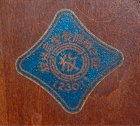

approval mark for Station-model set (25mm width)
(Reg. No. 305322、10/08/1938)
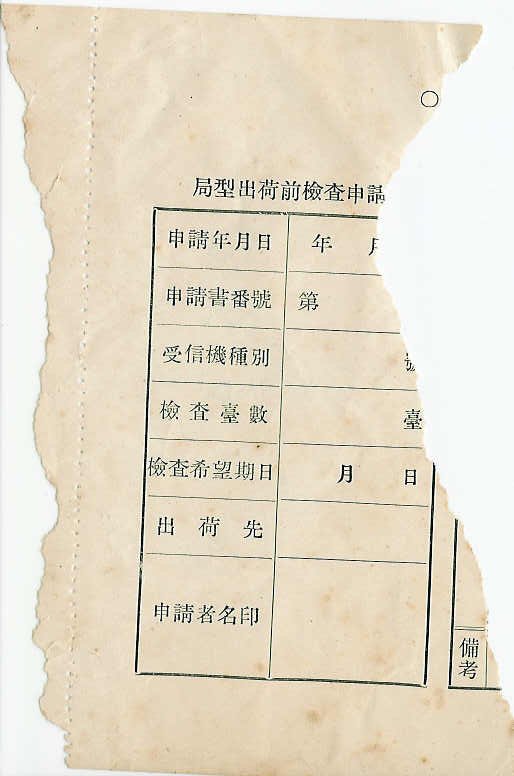
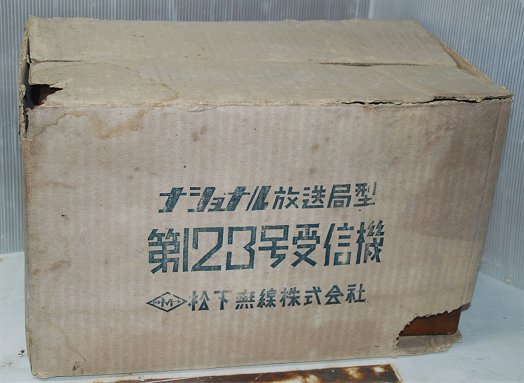
(Left) Inspection Sheet (Right) Original Carton Box for Type No.123
receiver(1944)
TOP
Type No.11 Receiver -Reduced Material Radio-
Saving strategic materials is very important demand for design of radio
sets at wartime.
In March 1, 1939, the technical specification of Type No.11 receiver was
announced.
Circuit of this receiver was conventional 3 tube regenerative receiver.
Line up of tubes is equal to Type No.1 receiver. It used grid detector
to improve sensitivity. And to reduce the size of power transformer, auto-transformer
was used. In 1939, production of type No.11 receiver was started, however
sales were not increased.
In August 7, 1939, "Station-model set" was authorized as standard
receiver by The Ministry of Posts and Telecommunications.
Then in August 10, exemption of commodity tax for Type No.11 receiver
was recognized.
From 1940, production and sales were increased. In 1941, subsidy for Type
No.11 receiver was started.
TOP
Type No.11 Receiver (Very Early Model) (June 1940) (Approved No.1103) Taiyo Radio Manufacturing Co., Ltd.
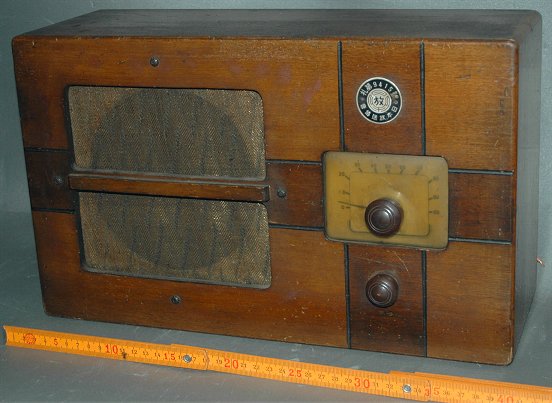
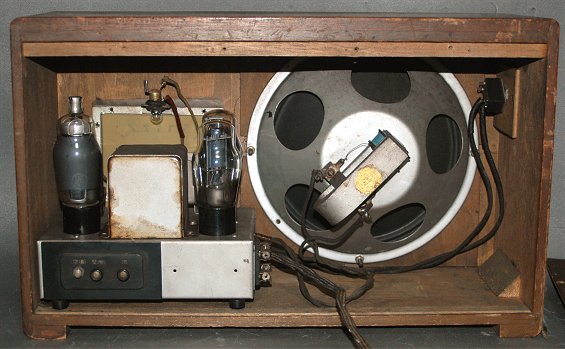
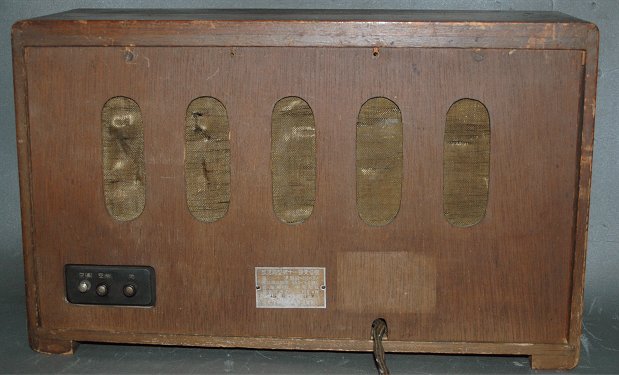
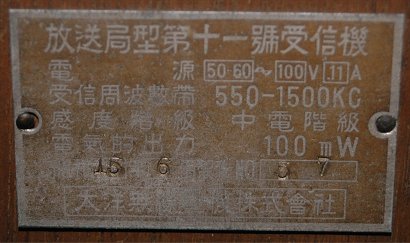
「エルマン」ブランドで知られる中堅メーカの局型11号受信機。Taiyo Radio Manufacturing Co., Ltd. was well known as "Elman" brand. 同社は11号の製作許可を1940年1月に受けているが、このセットは同年6月製で製造番号が57番と極めて若い。同社最初のロットの製品と思われる。カバー付のトランス、大型の端子板が初期型の特徴。スピーカはまだ鉄フレームのものが使われている。
Knob was fixed up side down. Larger knob fixed lower posittion is correct.
(Collection No.11789)
TOP
Early Model of Type No.11 receiver (1940) mfr. The Osaka Musen Co., Ltd.
(Approved No.: 1106)
TUBES: 57-47B-12F Magnetic Speaker
Early Model of Type No.11 receiver (Sept. 1940) (Approved No.1106) The Osaka Musen Co., Ltd
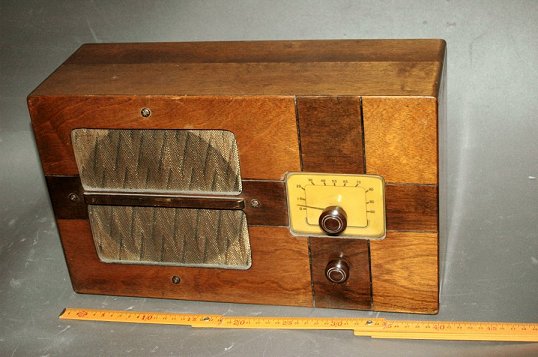
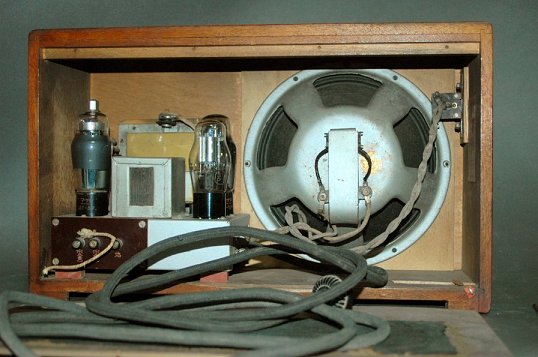
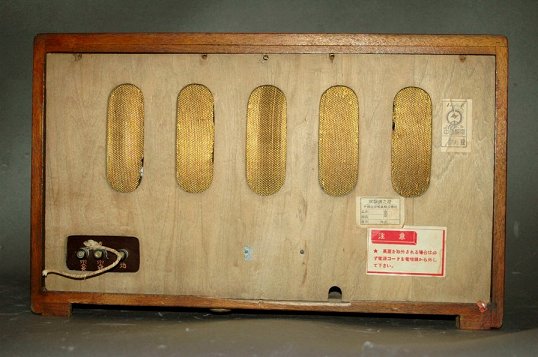
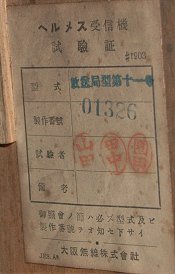
By using auto-transformer, primary circuit is connected to chassis directly.
To reduce electric shock, chassis is isolated from enclosure. Rear cover was fixed by screws.
And a caution label to avoid electric shock was indicated on rear cover.
This is very early mass produced set. Serial No. is 1326 (may be first
lot of this manufacturer)
This set keeps very good condition except missing nameplate.
Knob was fixed up side down. Larger knob fixed lower posittion is correct.
(Collection No.11614)
TOP
Later Model of No.11 Receiver (1941) (Approved No.11014) Hakusan Musen Denki K.K.
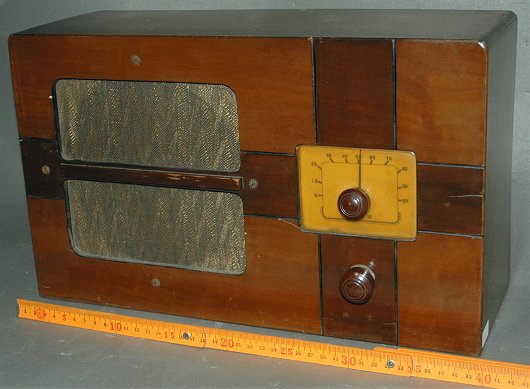
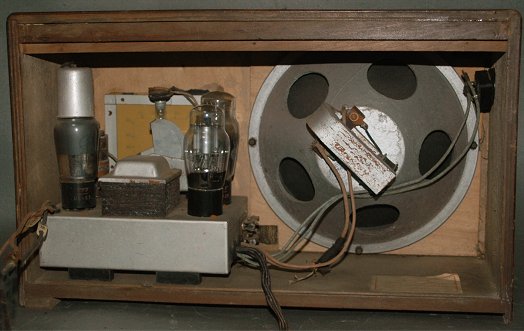
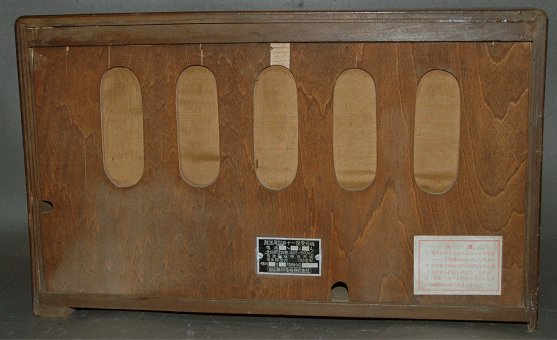
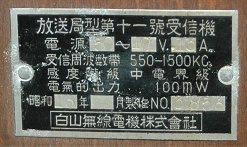
The Hakusan Musen Denki K.K. was approved in 10/1/1941.
This set is early set of this manufacturer.
Following improvement was added to specification in 28/1/1941.
・ Antenna and earth terminal was omitted and pulled out from chassis directly.
・ Shield cap added to detector tube to prevent interference.
Other design was based on early specification.
(Collection No.11838)
TOP
Later Model of type No.11 Receiver (09/1942) (Approved No.1106) The Osaka Musen Co., Ltd
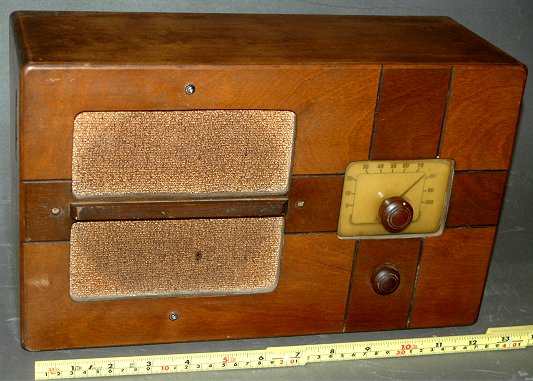
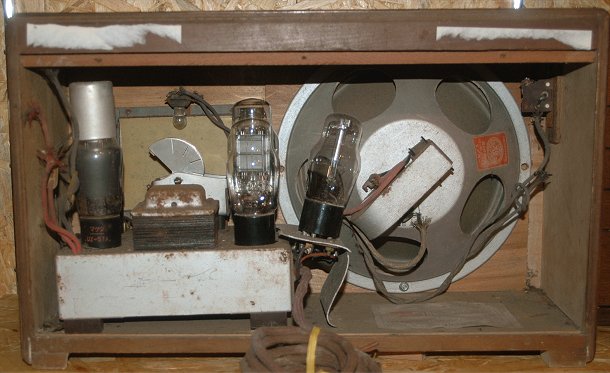
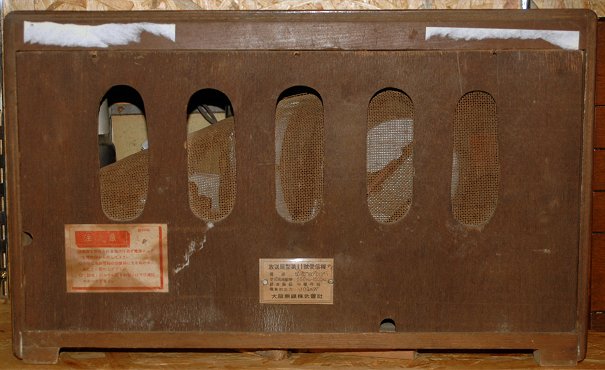
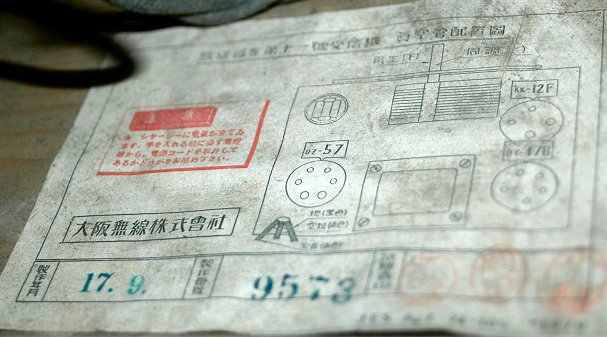
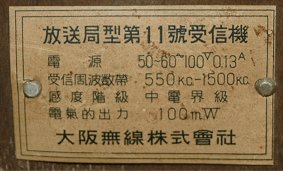
上の初期型と同じ大阪無線の昭和17年製のセット。この間に発表された許容事項が取り入れられている。スピーカが紙製フレームになり、シャーシの端子板が省略され、トランスのカバーが簡略化された。また、製造年月日と製造番号が内部の配置図に記入できるようになり、銘板の表記は略された。スピーカのサランネットも、初期のものは仕様書どおりのデザインだが、このセットには手持ちのものを使ったと思われる仕様書と異なるデザインの布が使われている。キャビネット側板は、当初の仕様では単板が指定されていたが、1941年末の許容事項でベニヤ板が認められるようになった。このセットではこの許容事項を取り入れて側板も合板になっている。キャビネットは大手のキャビネットメーカであるオカダケースで製作された。この時代の局型受信機としては良い仕上げである。
発売から2年経過しても製造番号が1万に達していない。この型式の台数が少なかったことを示している。
本機は、感度を改善するために56による増幅段がシャーシを追加して付加されている。この改造は戦後のものと思われる。写真は、つまみの取り付けが逆になっている。同調側に小さいツマミが付くのが正しい。また、スピーカの止めねじは最近交換された新しいものである。
(Collection No.11570)
TOP
Later Model of Type No.11 Receiver (after 08/1942) (Approved No.11014) Hakusan Musen Denki K.K.
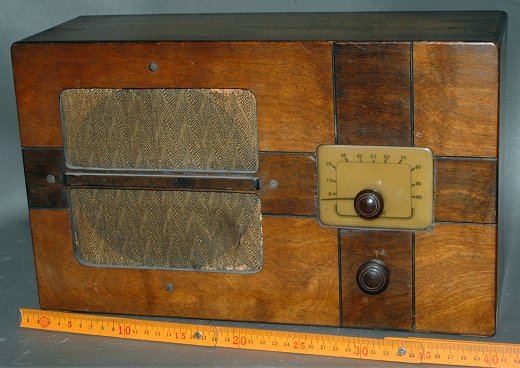
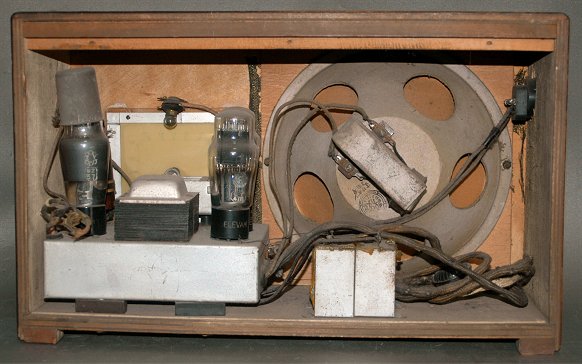
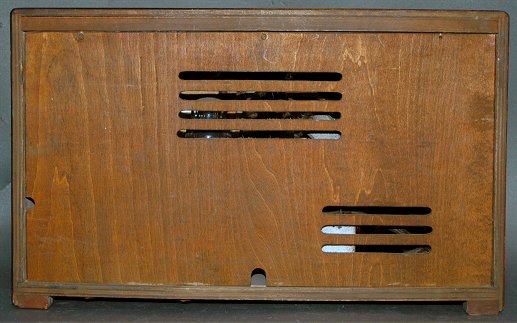
The Hakusan Musen Denki K.K. was approved in 10/1/1941.
This set is later model of No.11 receiver.
In 29/5/1942, The design of rear panel was simplified.
The chassis and cabinet is similar to early model.
Nameplate is missing.
(Collection No.11386)
TOP
Kahoku Standard No.11 Receiver The Nihon Seiki Co., Ltd 1940
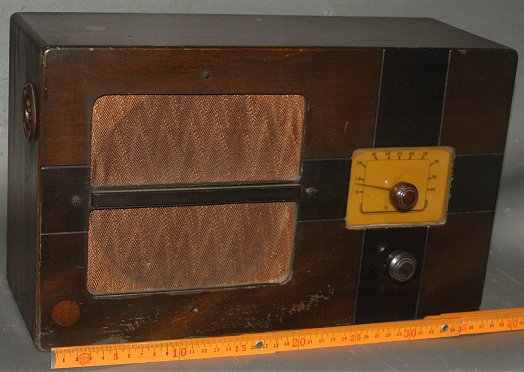
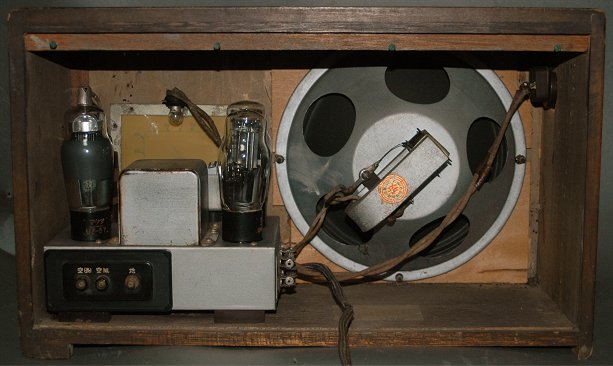
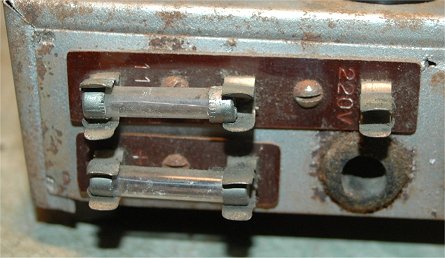
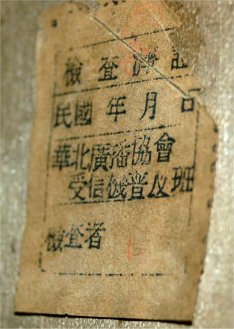
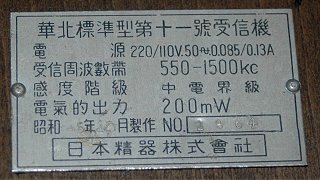
北支(中国北部)の占領地域で使用された受信機。放送局型11号受信機と基本的に同じもの。電源電圧が110/220Vとなり、ヒューズホルダの形状が異なるのみである。57-47B-12F
のセミトランスレス式3球でマグネチック・スピーカを駆動する。スピーカが鉄フレームであること、また、アンテナ端子版の形状から、ごく初期型のものであることがわかる。前面パネル左下に北支標準型3号受信機と同じマークがついていることがわかる。
(Collection No.11625/11851)
TOP
Development of Transformer-less Receiver
In August 1939, new tubes for transformer-less receiver were announced.
These tubes were developed by NHK and Toshiba. To reduce power consumption,
heater current was determined to 150mA.
Japanese radio used 3 or 4 tubes. Total voltage of series connected 3 or 4 tubes is lower than line voltage (100VAC).
Ballast lump was connected to series to the heater of tubes. 3 types of
ballast lump (B-37, B-49, B-61) was produced.
The number of ballast lamp means voltage drop. Power tube was not beam
type tube.
To supply enough plate voltage, multiplying rectifier was used.
Development of new transformer-less receiver was continued by the technical
laboratory of NHK. 3 types of receivers were planned.
Type No.21 and 22 were 3 tubes regenerative receivers. Type No.23 was 4
tubes receiver with RF stage.
Type number was finally changed into No.121, 122 and 123.
Type No.121 was used half-wave rectifier to reduce power consumption.
However output power was not enough. Type No.121 was not released.
In October 1940, Type No.122 and 123 receiver were released officially.
Type No.123 receiver was most mass produced "Station-model set".
The line-up of tubes was 12Y-V1 - 12Y-R1 - 12Z-P1 - 24Z-K2 - B-37.
By using multiplying rectifier, chassis was always “hot” voltage”. To reduce
electric shock, chassis is isolated from enclosure.
Rear cover was fixed by screws. And a caution label to avoid electric shock
was indicated on rear cover.
Antenna and earth cable were isolated by capacitor.
To reduce using of metal, the frame of speaker was made by pressed paper. Such “paper framed speaker” was used firstly for model DKE1938 receiver in Germany in 1938.
TOP
Type No.122 Receiver (Early model) Nanao Radio Co., Ltd. (Approved No.12207) (11/1941) Official Price JPY
42.30
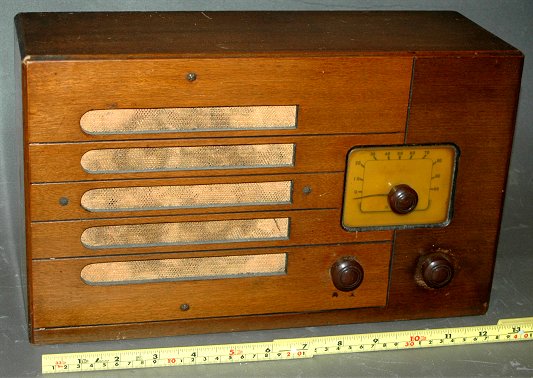
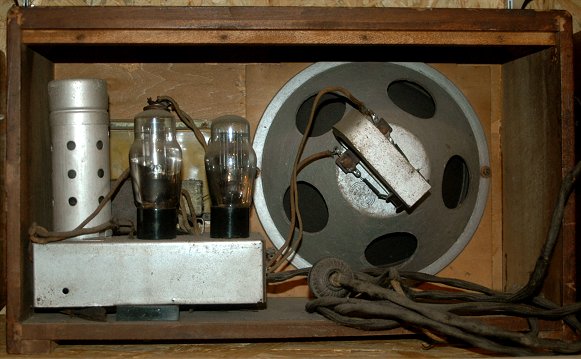
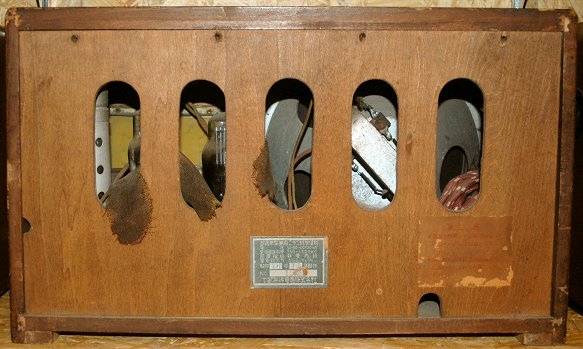
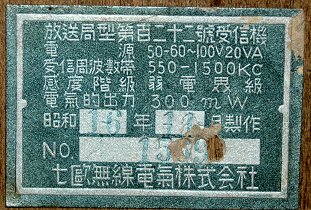
TUBES: 12Y-R1 - 12Z-P1 - 24Z-K2 - B-49 Magnetic Speaker
Early model of No.122 Receiver. Simplified design was “Art-Deco” style.
"Early Station-model Set" was faithful to the official specification.
Differences between manufacturers were very little. In original design,
antenna and ground terminal placed on the back of chassis. Specification
was changed. Terminal was deleted. Lead wire pulled out from chassis directly.
The net on the rear cover was lost.
(Collection No.11016)
TOP
Type No.122 Receiver Ishikawa Musen Denki K.K. (12/1941) Official Price JPY 42.30
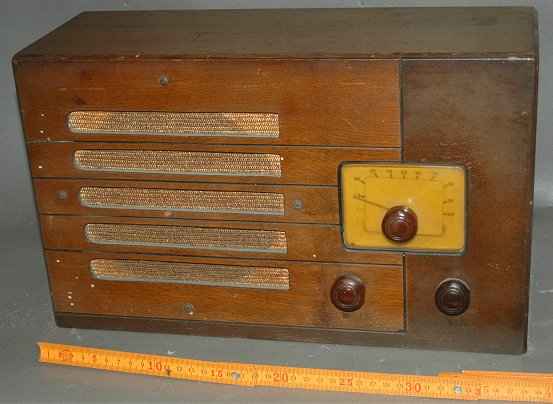
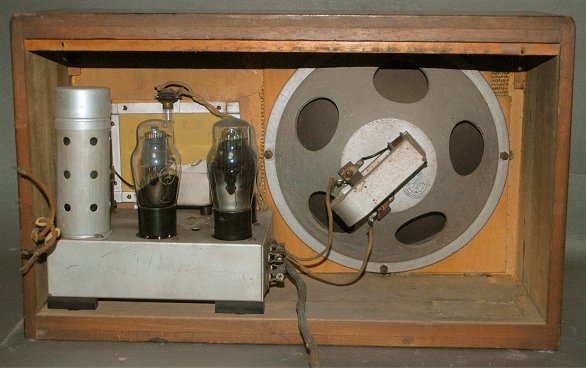
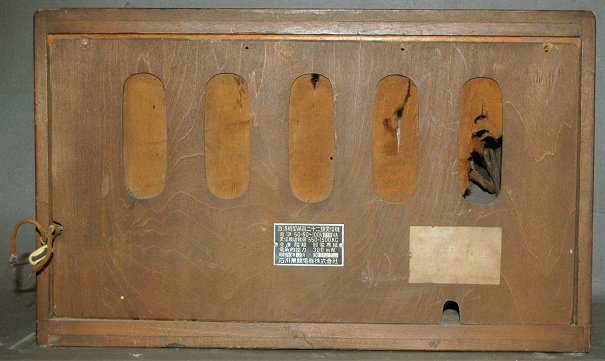
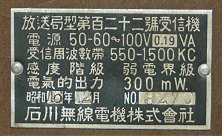
Ishikawa Musen Denki K.K was well known as "Wave" brand.
specification. Differences between manufacturers were very little. In original design, antenna and ground terminal placed on the back of chassis. Specification was changed. Terminal was deleted. Lead wire pulled out from chassis directly.
(Collection No.110531)
TOP
Type No.123 Receiver (Very Early Model) Nanao Radio Co., Ltd. (Approved No.12306) (08/1941) Official Price JPY
57.60
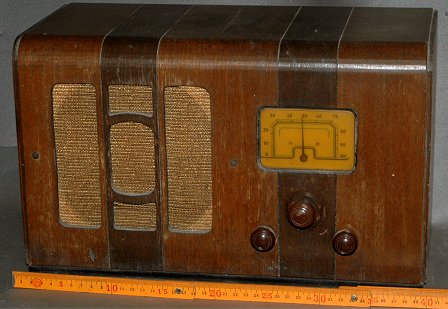
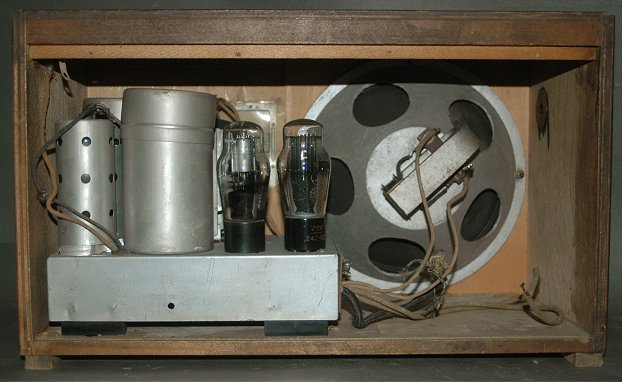
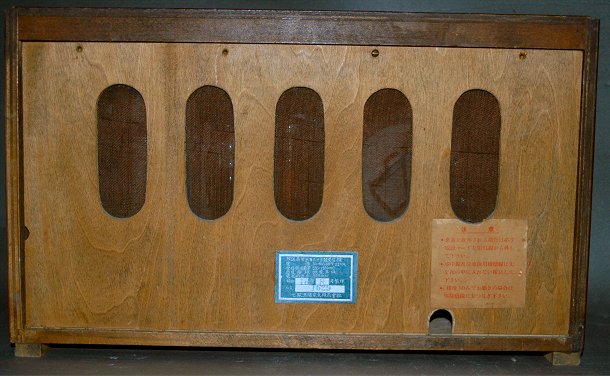
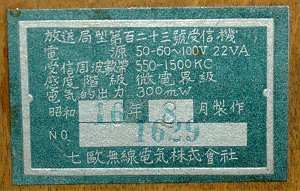
Rear cover was painted with net. (Left) Early model had dated nameplate
on the rear cover (Right)
開戦前の日付のあるごく初期の七欧無線製のもの、ダイヤルに減速機構があり、コイルケースがあるのが特徴。当初の設計では、スイッチ付ボリュームが指定されていたが、この初期の段階でも独立したスイッチが側面に付けられた(現在は失われている)。質の良いスイッチ付ボリュームの入手が困難だったためという。本来の仕様書ではアンテナとアース線はシャーシ後部側面から端子盤を介して引き出すようになっているが、すぐに許容事項としてシャーシ上部の穴1ヶ所から引き出す形に改められた。同社の認証は1941年5月なので、初期ロットのものと思われる。
(Collection No.11385)
TOP
Type No.123 Receiver (Early Model) Haraguchi Radio Co., Ltd. (Approved No.123011) (03/1942)
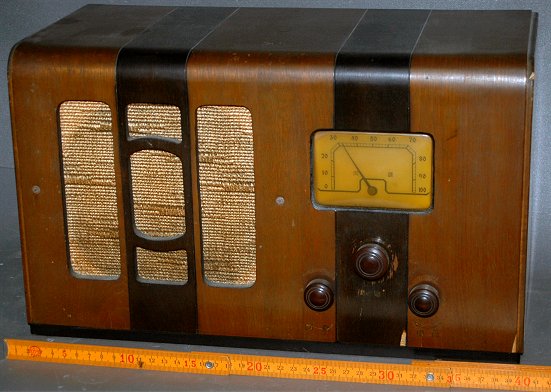
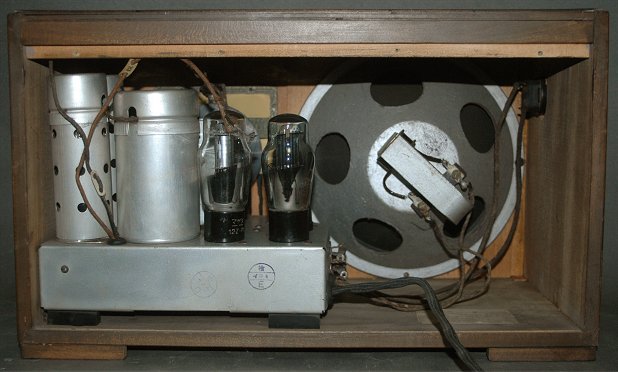
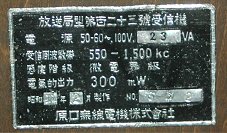
Early designed No.123 Receiver manufactured at 1 year after from first
production.
Original specification demanded using volume control with power switch.
However, the supply and quality of parts was poor, separated power switch
placed on the left side of cabinet.
THe cabinet of this example keeps very good original condition.
(Collection No.11357)
TOP
Columbia Type No.123 Receiver (Early Model) Nittiku Shokai (Approved No.123014) (1942?)
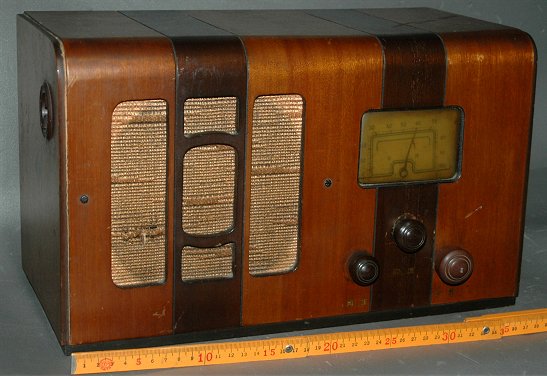
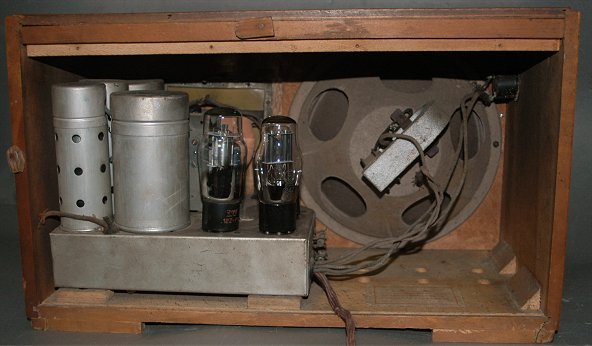
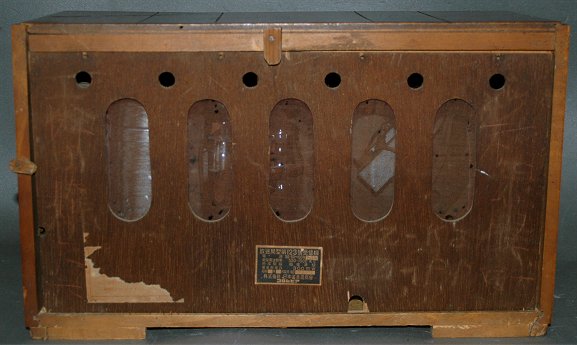
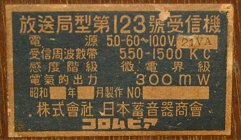
局型製造者としては後発であるコロムビアの123号受信機。高級ラジオや電蓄メーカの同社らしく、キャビネットの仕上げが良い。銘板の項目や並び順は仕様書どおりだが、メーカによって個性があることがわかる。算用数字で「123」と表記するのは厳密には正しくない。局型受信機で「コロムビア」という、ブランドネームを入れているものは珍しい。キャビネットの床と裏蓋に、仕様書にはない穴が追加されている。放熱に問題があったのだろう。裏蓋の穴はこれとは違った形で許容事項として追加されている。銘板の製造年月日の捺印は消えてしまっているが、日本蓄音器商会は、1942年9月21日に日蓄工業(株)に社名変更されている。このセットは製作許可を受けた1941年11月から社名変更までの間に作られたセットである。
右側の大きなツマミはオリジナルではない。また、ねじ止めの裏蓋を簡単に外せるように木片を追加して改造している。
(Collection No.11800)
TOP
Reinforcement of control for Radio
戦争の激化により民需用ラジオ向けの資材の供給事情が悪化し、統制が強化された。本格的な統制が行われたのは1940(昭和15)年以降だが、1938(昭和13)年から業界団体であるラジオ工業組合によるラジオ用品規格統一委員会が部品の統一規格を検討し、統一委員会は1939年9月、資材に関する連絡調整も行うラジオ用品委員会と改称された。これによりラジオ用部品は局型用の部品を基本とした物に統一された。
1940年12月6日、価格統制令に基づき、商工省告示第799号でラジオ受信機の公定価格が定められ、ラジオの種類が局型受信機3種類(11、122、123号)を含む14種類に限られることになった。放送局型第1号、3号受信機はこの中に含まれなかった。従って、仕様書は生きていてもこの時点で消滅したといえる。また、1942年10月12日以降、放送局型受信機事務取扱内規が改正され、「第3号」の表記を「第123号」に改めることになった。
標準品種となったものの感度が低く、販路の限られる11号、122号受信機は人気がなく、1943年以降ほとんど生産されなくなる。
資材の逼迫と統制の強化は価格競争力の低い放送局型受信機に有利に働いた。1941年に放送協会と日本ラジオ工業組合連合会が共同で局型需給調整委員会を結成した。この事は局型製造業者に対し資材の入手面で有利になるということであった。
戦争が本格化するに連れてラジオ部品の入手は困難になっていった。このなかで1942年9月8日、東西ラジオ組合、日本ラジオ工業組合連合会は解散し、電気機械統制会傘下のラジオ受信機統制組合が結成された。統制組合の主要メンバーは局型製造業者であり、資材配給面で局型受信機が優遇されるようになった。これに先立ち1942年9月7日をもって放送局型受信機需給調整規定は廃止され、局型需給調整委員会は解散した。ただし、実務として需給調整は引き続き継続される事になったようである。1943年1月1日にラジオ受信機配給会社が設立され、同年、企業整備令により小売店が整理されて統制組合が設立され、ラジオの出荷検査を統制会が行うようになり、統制組織が完成した。
このような中で1942年には38万台の局型受信機が生産された。その半数近い17万台余りが123号受信機であった。この数字は統制組合によるものだが、商工省の統計によるこの年の再生受信機の全生産台数は79万台余りで、約その半数を局型受信機が占めていたことがわかる。
配給により局型受信機が供給されるようになると、宣伝の意味はなくなってくる。一般の受信機と競争していた時代はともかく、統制が厳しくなった後は、専門誌などに、どのメーカも同じ様式の広告が掲載されるのみとなった。
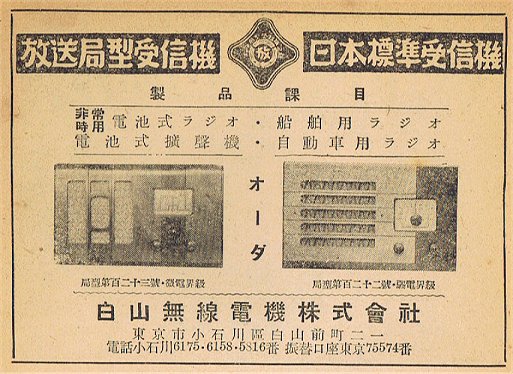
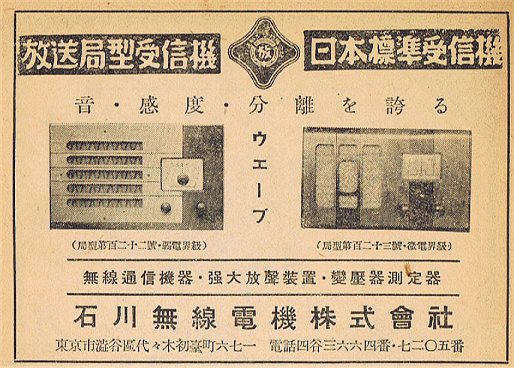
局型受信機の広告(ラジオ年鑑、昭和18年版、1943.1)
メーカ名や宣伝文句が異なるのみでまったく同じ様式の広告が並んでいる。
TOP
Improvement of Type No.123 Receiver -Temporarily Permitted Model-
According to the rules of "Station-model set", circuit, parts and design were due to the specification completely.
However, to use the materials owned by manufacturer, some modification (color of chassis, design of speaker cloth etc.) was allowed.
To reduce materials, some improvement was added to specification.
Following modification was added.
・ Thickness of chassis was changed from 0.7mm into 0.5mm. (21/02/1941)
・ Antenna and earth terminal was omitted and pulled out from chassis directly. (21/02/1941)
・ The quality of power switch with Volume control was poor and difficult
to get, ended up allowing independent power switch on the left side of
cabinet.
・ Variety of woods for cabinet was allowed (27/11/1941)
・ The place of serial number and date was changed from name plate on rear panel into tube location diagram inside cabinet. (22/01/1941)
In March 1942, the specification of type No.123 receiver was changed.
The changed receiver was called “Rinji-kyoyou” (temporarily permitted model).
TOP
Type No.123 Receiver (early temporarily permitted model) Tiger Electric Co., Ltd. (Approved No.12305) (1942?)
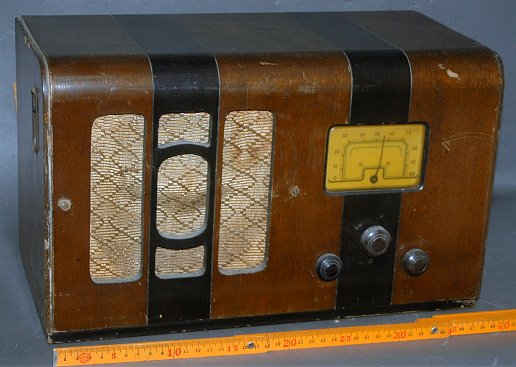
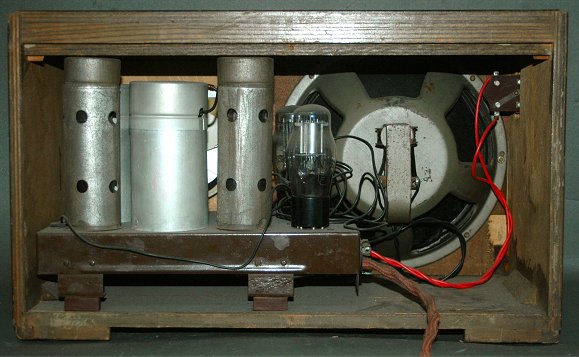
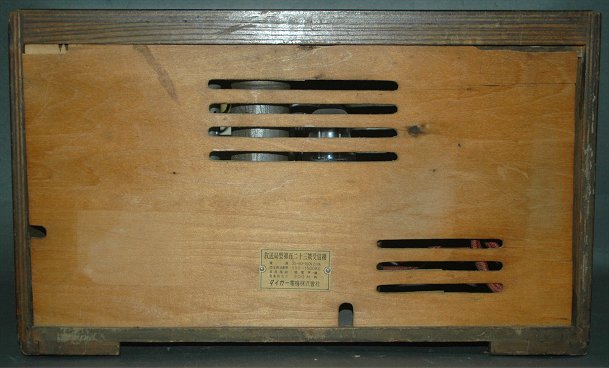
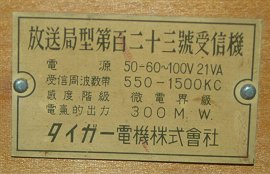
大阪の中堅メーカ、タイガー電機の123号受信機。全体としては初期型だが、裏蓋などに許容事項が取り入れられている。シャーシは他社に見られない側板が短いもので、レイアウトも本来の仕様書とは異なっている。局型受信機のシャーシは銀色が一般的だが、このシャーシの色がこげ茶色なのは、同社が従来からシャーシに使用してきた塗装色のため。当初は細部にいたるまで放送協会の仕様書で規定されていた局型受信機だが、次第に現状に合わせて各メーカの手持資材にあわせたモディファイが許されるようになった。
製造年月日は不明だが、同社は1943年6月に敵性語排除のため利根無線と改称するため、1942年の製品と思われる。なお、鉄フレームのスピーカはオリジナルでない。また、ごく最近修理された痕跡がある。
(Collection No.11410)
TOP
Type No.123 Receiver (temporarily permitted model) Matsushita Radio MFG. Co., Ltd. (Approved No.12309) 04/1942
Officaial Price JPY 61.40
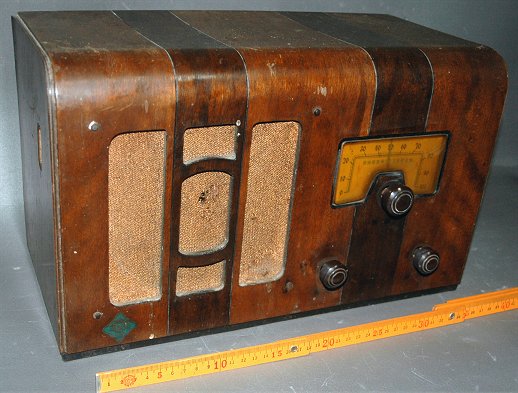
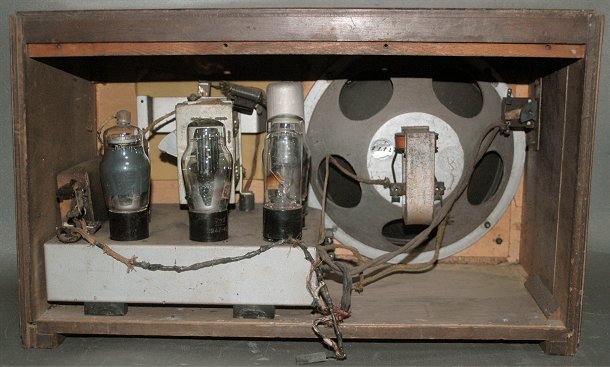
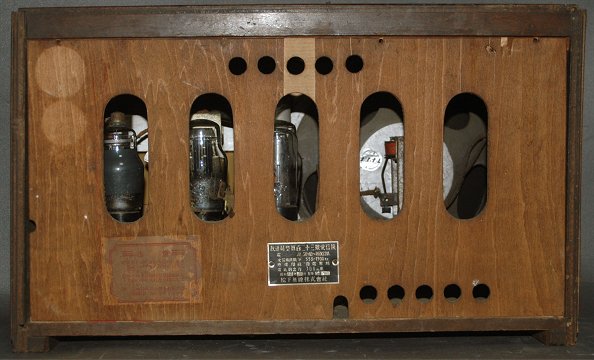
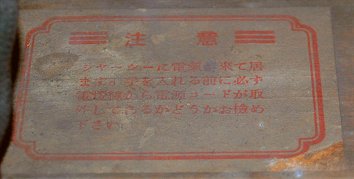
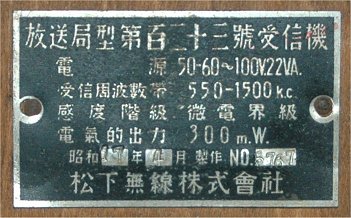
松下の臨時許容型。「放送局型第123号(臨時許容)」として昭和17(1942)年3月18日に仕様書が発行された直後の製品。ダイヤルのデザインとシャーシのレイアウトが変更され、裏蓋に放熱孔が追加された。裏蓋の銘板と内部の注意ラベルは初期型のままで、当初の仕様書にない真空管配置図は付けられていない。
本機は、裏蓋のネットが失われている。
(Collection No.11737)
TOP
Type No.123 Receiver (early temporarily permitted model) Yaou Musen Denki Seisakusho (Approved No.123015) (05/1942)
Officaial Price JPY 61.40
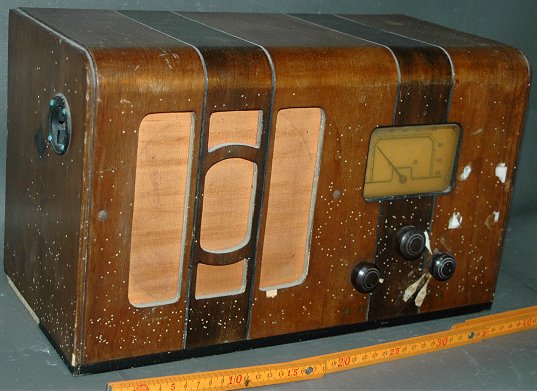
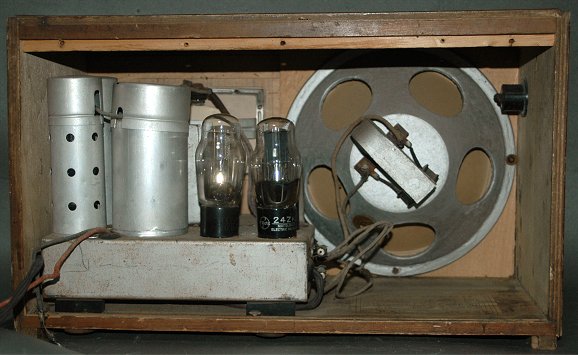
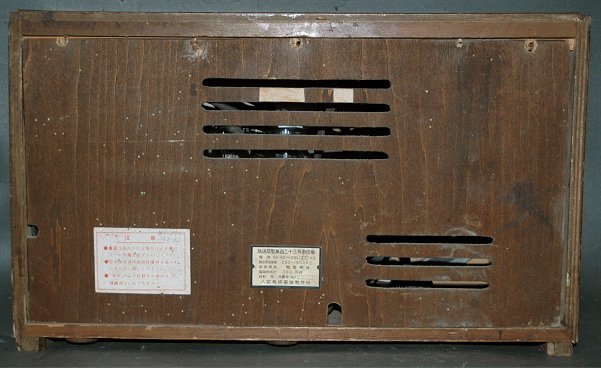
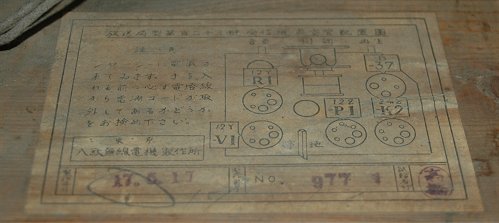
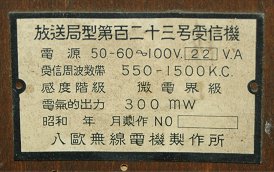
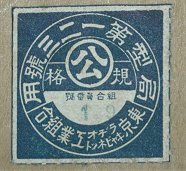
蓄音器メーカからラジオに進出した新興企業、八欧無線の123号受信機。1942年1月に製作許可を受けてから4ヵ月後の初期の製品である。キャビネットは初期型だが、一部に許容事項を一部取り入れている。ダイヤルや部品配置が大幅に変更された臨時許容の仕様書は1942年3月に発表されている。製作許可が下りて、初期型の仕様書で生産の準備をしていたものと思われる。日付と製造番号をセット内部の真空管配置図に記入する許容事項が適用されているため、裏蓋の銘板には日付と番号がない。裏蓋のデザインは、同年5月29日に発表されている。こちらのセットの製造年月日は5月17日のため「勇み足」となっている。キャビネットに、キャビネット工業組合の証紙が貼ってあることから、内作ではなくキャビネットメーカから購入していたと推定される。
本機は、本来12ZP1である出力管がUY-27Aに改造されている。
(Collection No.11793)
TOP
Type No.123 Receiver (temporarily permitted model) Hayakawa Electric Industry Co., Ltd. (Approved No.12308) (05/1942)
Officaial Price JPY 61.40
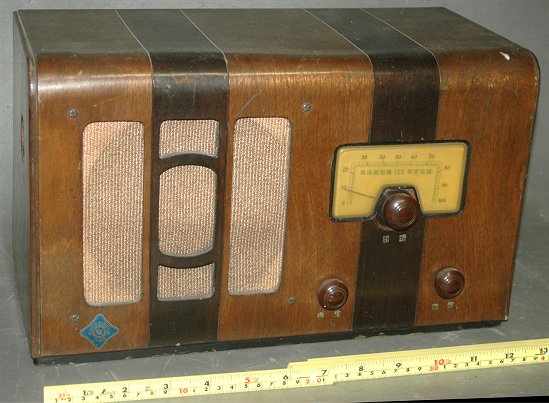
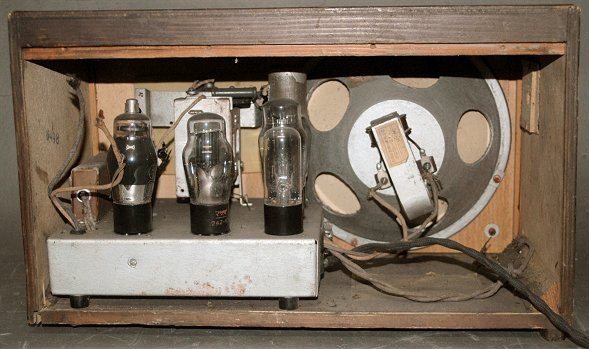
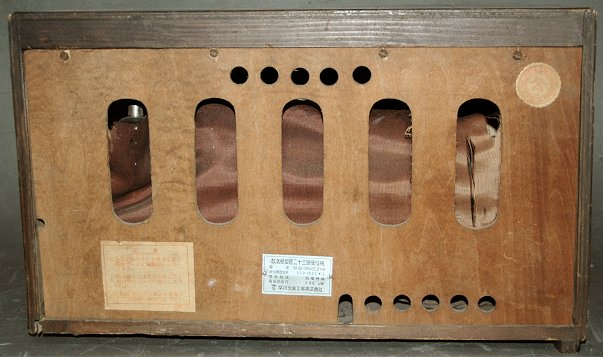
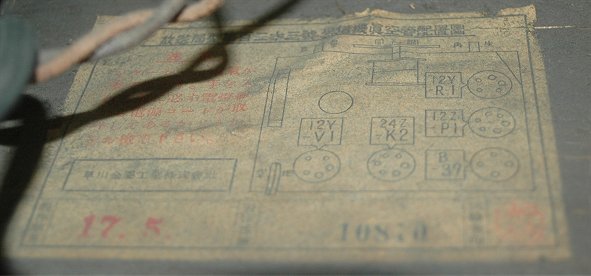
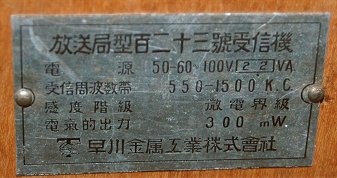
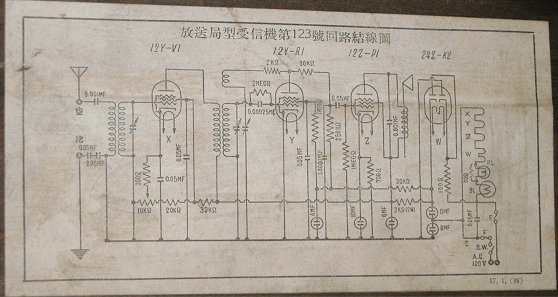
裏蓋の銘板(左)と底に貼られた回路図(右)、回路図の表示は義務ではないが、各社の通常の製品同様に表示されていた。
シャープの臨時許容型。「放送局型第123号(臨時許容)」として昭和17(1942)年3月18日に発行された仕様書どおりの製品。ダイヤルのデザインとシャーシのレイアウトが変更され、裏蓋に放熱孔が追加された。また、日付と製造番号をセット内部の真空管配置図に記入する許容事項が適用されているため、裏蓋の銘板には日付と番号がない。
(Collection No.11573)
TOP
Type No.123 Receiver (temporarily permitted model) Nanao Radio Co., Ltd. (Approved No.12306) (10/1942) Officaial Price JPY 61.40
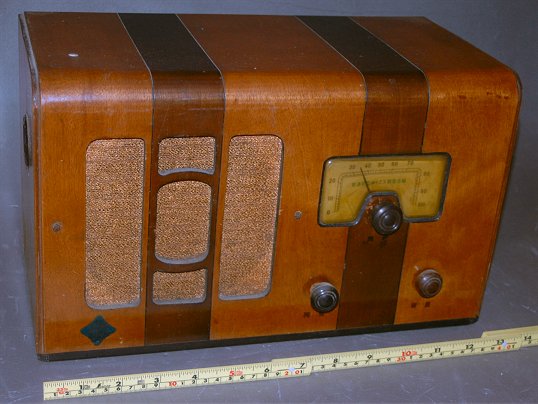
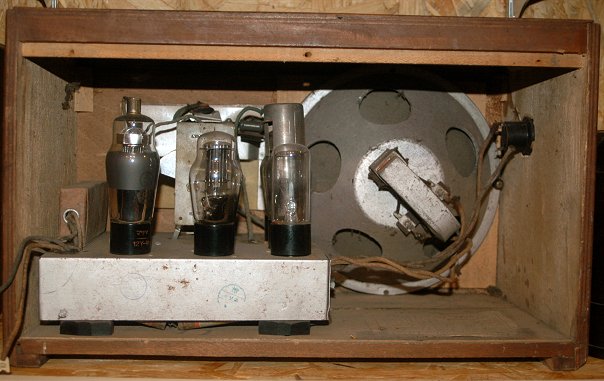
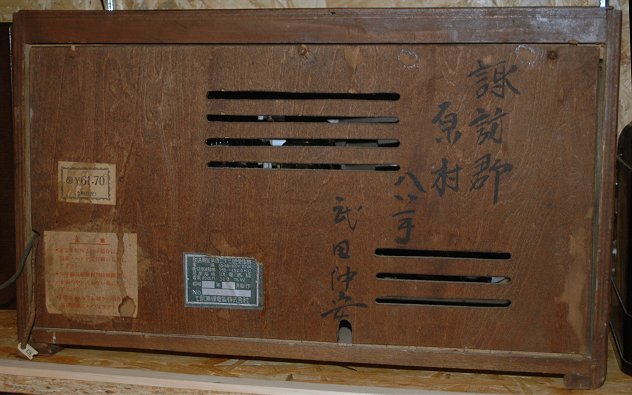
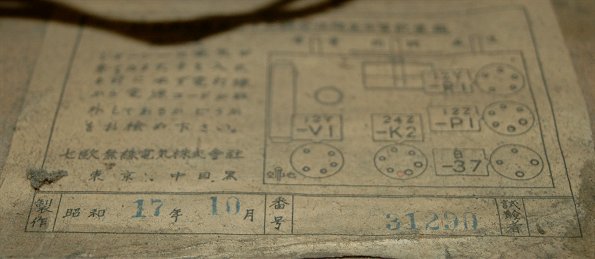
長野県諏訪郡原村の所有者名が記載されている。
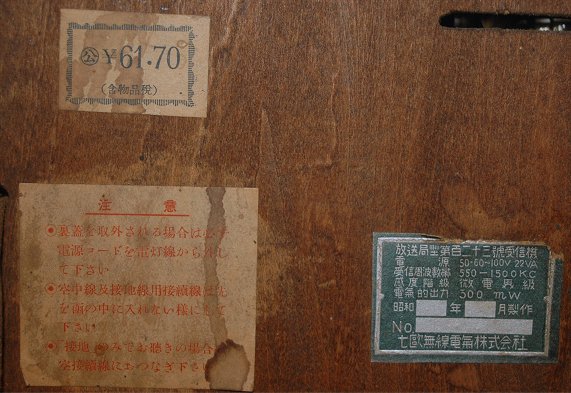
裏蓋に公定価格のラベルがある。内部の配置図に日付と番号が入っているため、裏蓋の銘板の表示は略されている。
七欧無線の臨時許容型。1942年5月の許容事項を追加し、裏蓋のデザインがよりシンプルなものになった。簡略化された裏蓋のスリットは、関西系のメーカの製品より幅が狭くなっている。同社の初期型と比較すると構造の違いがよくわかる。「臨時許容」の仕様書ではスピーカの止めねじは簡略化された飾りねじ4本であるが、このように初期型と同じ2本止めのセットも多かった。また、日付と製造番号をセット内部の真空管配置図に記入する許容事項が適用されているため、裏蓋の銘板には日付と番号がない。本来警告文が赤で2色刷りとなっていた配置図が、単色に変更されている。その製造番号は3万台を超えていて、量産されたことがよくわかる。同社は1943年までこのデザインで生産を続けている。
(Collection No.11573)
TOP
Type No.123 Receiver (temporarily permitted model) Tone Musen K.K. (Approved No.12305) 08/1943
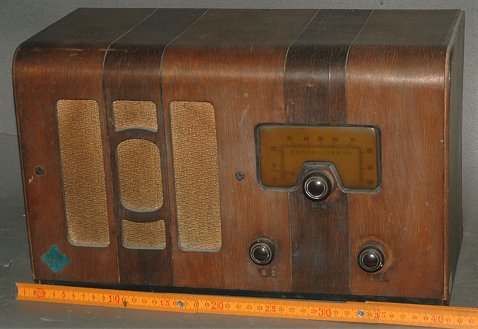
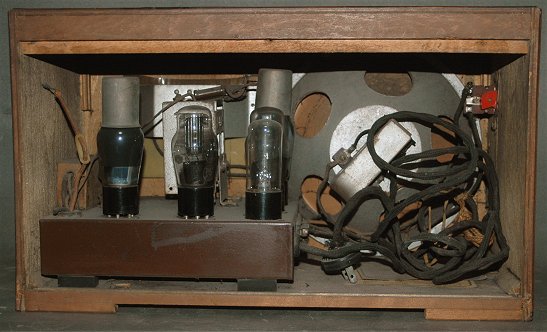
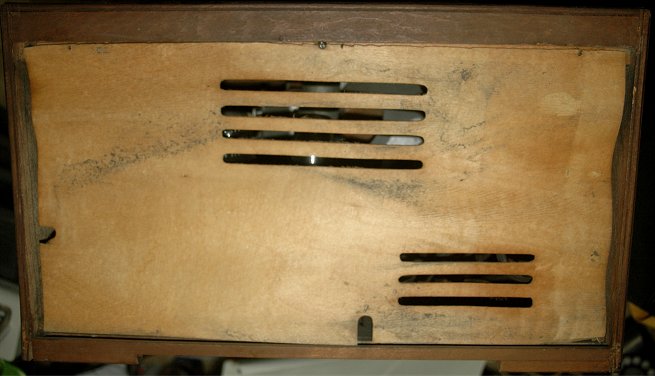
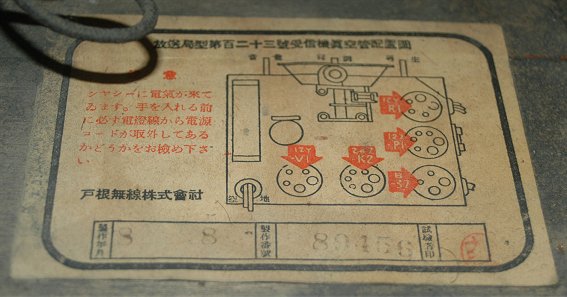
タイガー電機から社名を利根無線と変更した直後の臨時許容型。変更内容がほぼすべて取り入れられている。当初は細部にいたるまで放送協会の仕様書で規定されていた局型受信機だが、次第に現状に合わせて各メーカの手持資材にあわせたモディファイが許されるようになった。同社の初期の臨時許容型と比較すると構造の違いがよくわかる。また、銘板の内容がセット内部の真空管配置図に統合される許容事項が適用されている。
このセットはキャビネットの褪色が激しい。
(Collection No.11244)
TOP
Lack of Materials, Last Model of Type No.123 Receiver
In 1942, the war situation grew worse. Limited materials were supplied
to military use. Materials for civilian radio sets were restricted.
Production of radio sets decreased from 1943. In 1943, the shape of type No.123 receiver was changed into simple design.
To reduce thickness of plywood, rounded shape of front panel was changed
into square shape.
The construction of chassis was not changed. 2 variation of dial existed.
In 1944, production of type No.123 receiver was only 35,000 sets.
It’s only 10% of the production of 1942.
This later model was called "Square Shape"
TOP
Type No.123 receiver (Square Shape) mfr: Matsushita Radio Mfg. Ltd. (Approved No.12309) 06/1944
Official Price JPY 81.80(after 1/3/1944)
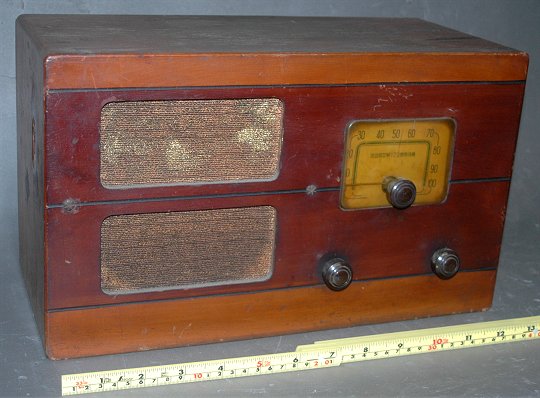
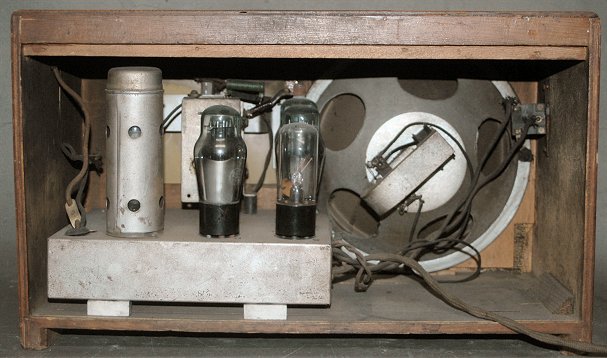
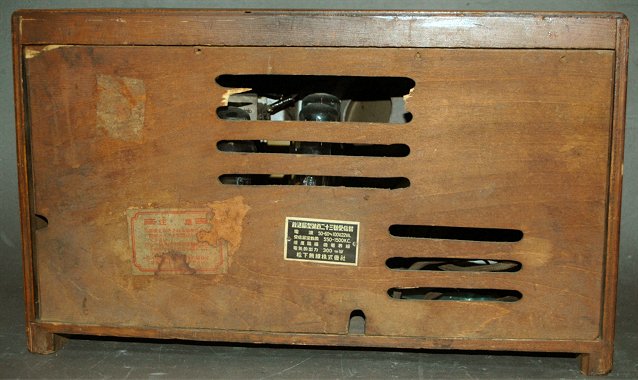
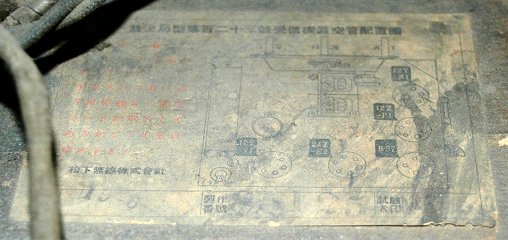

TUBES: 12Y-V1 - 12Y-R1 - 12Z-P1 - 24Z-K2 - B-37 Magnetic Speaker
The design of dial was deferent from former model.
(Collection No.:11287)
TOP
Type No.123 receiver (Square Shape) mfr: Hakusan Musen Co., Ltd (Approved No.123012) 05/1944
Official Price JPY 81.80 (after 1/3/1944)
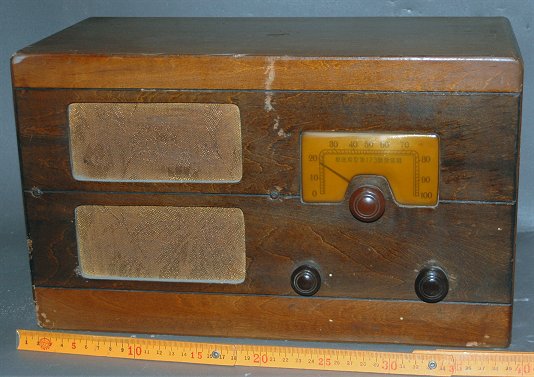
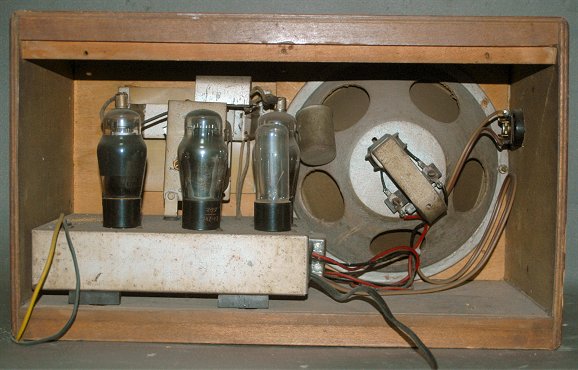
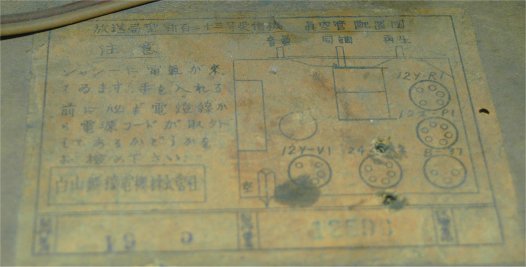
TUBES: 12Y-V1 - 12Y-R1 - 12Z-P1 - 24Z-K2 - B-37 Magnetic Speaker
The design of dial equaled to former model
(Collection No.:11529)
TOP
Type No.123 receiver (Square Shape) Mitaka Denki K.K. (Approved No.123013) 1944? Official Price JPY 81.80 (after 1/3/1944)

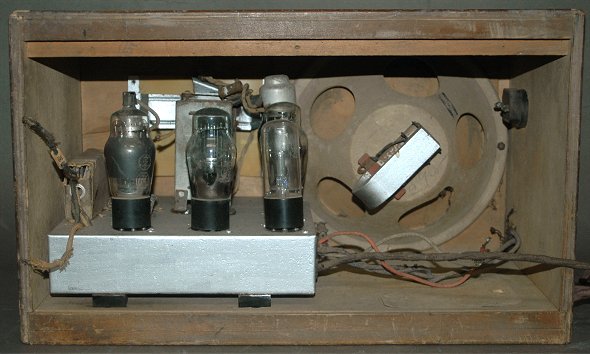
関東系の大手メーカ、アリアのミタカ電機の角型。ダイヤルの窓は臨時許容型のものだが、目盛板は最終型独自のタイプを使用している。
ダイヤルのデザインについては関東系と関西系というような区別はなさそうである。
Chassis was repainted. Net was broken. Rear cover was missing.
(Collection:11360)
TOP
Type No.123 receiver (Square Shape) Haraguchi Radio Co., Ltd. (Approved No.123011) 1944
Official Price JPY 81.80(after 1/3/1944)
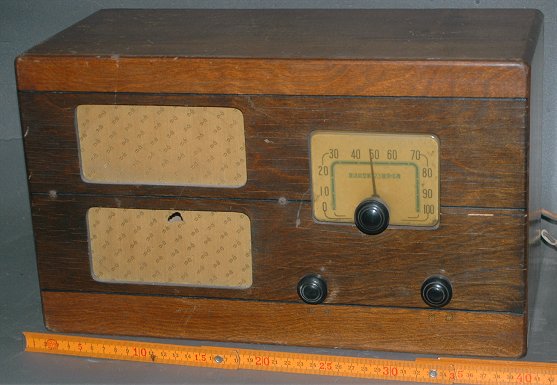
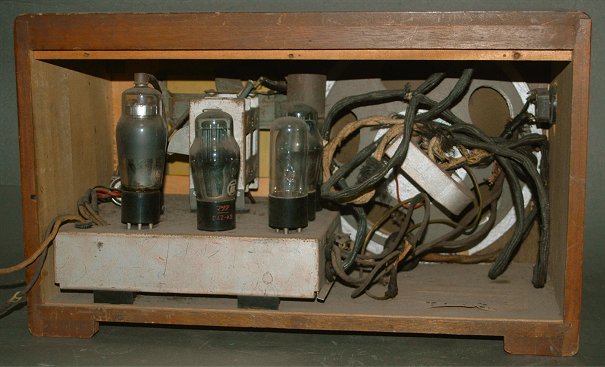
角型の原口無線製123号受信機。同社の初期型と比較すると、いかに簡素で貧弱になったかがよくわかる。アルミのシールドケースは廃され、ブリキ製の最小限のシールドキャップが使われている。原口無線も本来の臨時許容型と異なるダイヤルを使用している。
(Collection番号:11225)
TOP
Type No.123 receiver (Square Shape) The Osaka Musen Co., Ltd. (Approved No.12307) 1944 Official Price JPY
81.80(after 1/3/1944)
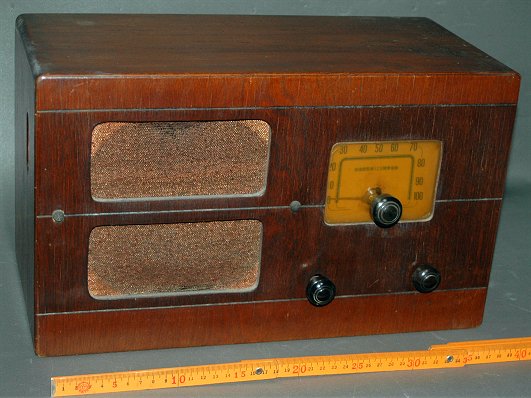
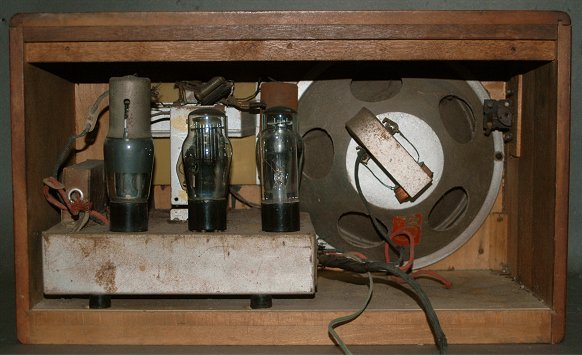
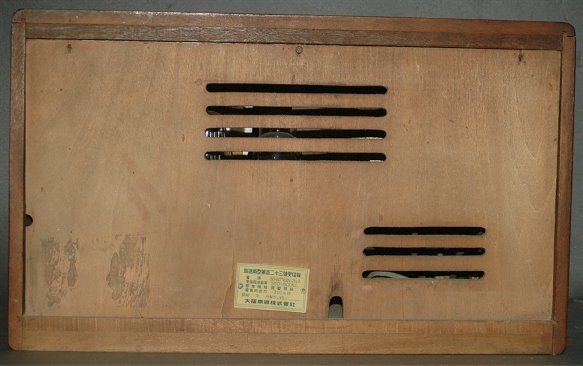
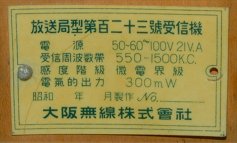
高級品メーカとして知られる大阪無線の123号受信機。このタイプのものとしてはキャビネットの仕上げは良い。
末期のモデルだが、銘板は初期型のように裏蓋に付けられている。左下の注意ラベルは失われている。
(Collection No.:11412)
TOP
The Technical Problems of No.123 Receiver
戦争末期になるとラジオセットだけでなく、部品の入手も非常に困難になってきた。当時は減球といって4球受信機を3球受信機にしたりしてとにかく聞こえるようにする修理(改造?)が良く行われた。このような時に一般的なトランス式の受信機は簡単に真空管を減らすことができ、また、旧式の真空管を含め、手持ちの適当な真空管を使えるように改造することも容易だった。 これに対しトランスレス受信機の場合、ヒータが直列になっている関係上、改造の自由度は低く、真空管の入手も容易ではなかった。
また、出力管がビーム管でなく、効率が低いために両波倍電圧整流を採用したことが信頼性を落とす事になった。片方の2極管部が劣化するともう一方の平滑コンデンサに逆電流を流してしまう。それでなくても質の低かった紙のケースに入れてパラフィンで封止しただけという電解コンデンサはすぐにパンクしてしまった。 また、「臨時許容」により変更された真空管のフィラメント接続は、配線を節約することはできたが、球に過大な電圧がかかることになり、信頼性を落とすことになった。 消費電力を減らすためにヒータ電流を150mAとしたことも悪化する一方の電力事情のもとではわずかな電圧低下で感度が下がることにつながった。
TOP
The Statistics of Production of "Station-model set"
| Type |
Region |
1940 |
1941 |
1942 |
1943 |
1944 |
1945(*) |
| 11 |
East |
22,288 |
50,825 |
29,430 |
2,366 |
290 |
0 |
| West |
17,429 |
24,470 |
23,699 |
1,450 |
0 |
0 |
| Total |
39,717 |
75,295 |
53,129 |
3,816 |
290 |
0 |
| 122 |
East |
395 |
45,146 |
27,251 |
610 |
0 |
0 |
| West |
0 |
29,906 |
28,609 |
0 |
0 |
0 |
| 小計 |
395 |
75,052 |
54,860 |
610 |
0 |
0 |
| 123 |
East |
341 |
53,769 |
134,209 |
94,020 |
12,263 |
300 |
| West |
0 |
59,993 |
140,497 |
104,890 |
22,750 |
800 |
| Total |
341 |
113,762 |
274,706 |
198,910 |
35,013 |
1,100 |
| Total |
40,453 |
264,109 |
383,695 |
203,536 |
35,303 |
1,100 |
From Radio Year Book 1947 (*) The number of 1945 is total from January
to August
Type No.11 the early model of "Station-model set" was fade out
in May 1944. No.122 was fade out in September 1943. Almost all of "Station-model
set" were type No.123. From 1941 to 42, the peak of production was
celebrated. It’s equal to total production of Japanese radio industry.
In 1942, a half of production was "Station-model set". Production
decreased from 1943. In 1945, the last year of WW II, production of "Station-model
set" was only 1,100 sets. However, radio sets were continued supplying
in August 1945.
TOP
After End of the War, from Station-model into Kokumin-gata
Under occupation by Allied Powers, GHQ demand prevailing of radios as tools
for democratization.
At the end of 1945, Japanese radio industry announced specification of new standard radio sets.
It named “Kokumin-gata“ radio. “Kokumin” means “national”. "Station-model"No.123 receiver
changed into “Kokumin-gata” No.1 receiver.
However, the quality of electric power was very poor. Voltage was not stabilized.
Transformer-less receiver was lack of sensitivity by low voltage.
And failure often caused by high voltage. Reliability was lower than conventional radio sets with power transformer.
The price of tubes for transformer-less receiver was expensive and production
was limited.
13 models of Kokumin-gata No.1 receiver were produced. However these radios did not prevailed.
One of them is stored in our museum. This is Clarion Kokumin-gata No.1 Receiver.
Japanese transformer-less receiver was prevailed after starting of mass
production of miniature tubes at late 1950’s
TOP
HOME
DATA
Circuit Diagrams
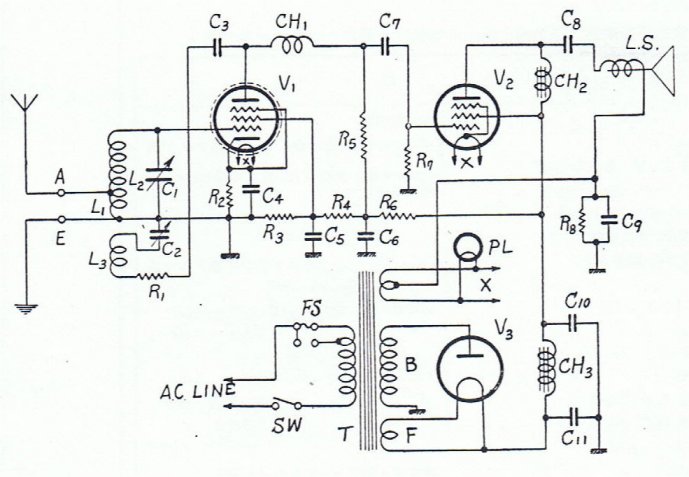
Type No.1 Receiver
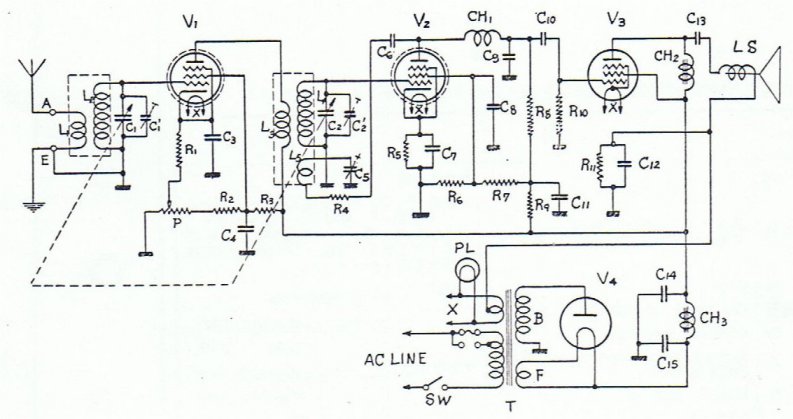
Type No.3 Receiver
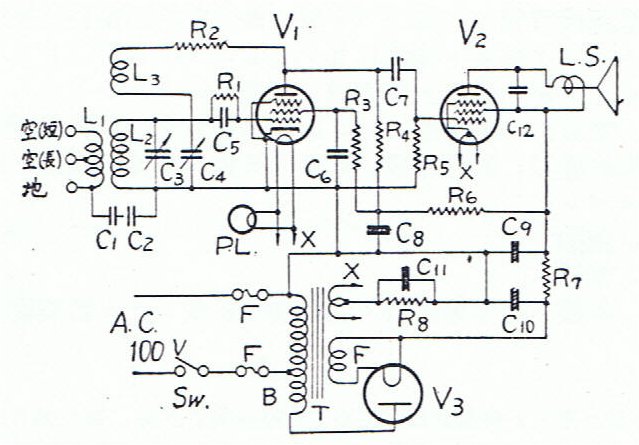
Type No.11 Receiver
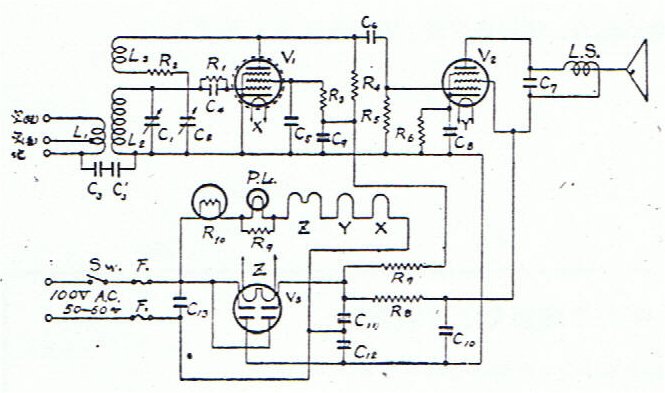
Type No.122 Receiver
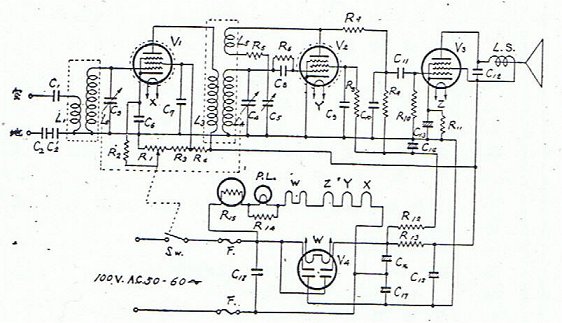
Type No.123 Receiver
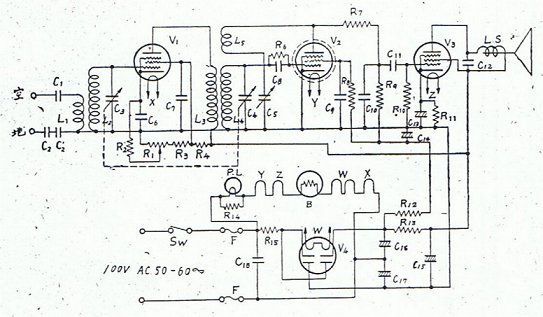
Type No.123 Receiver (Rinji Kyoyo)
TOP
HOME














































































































